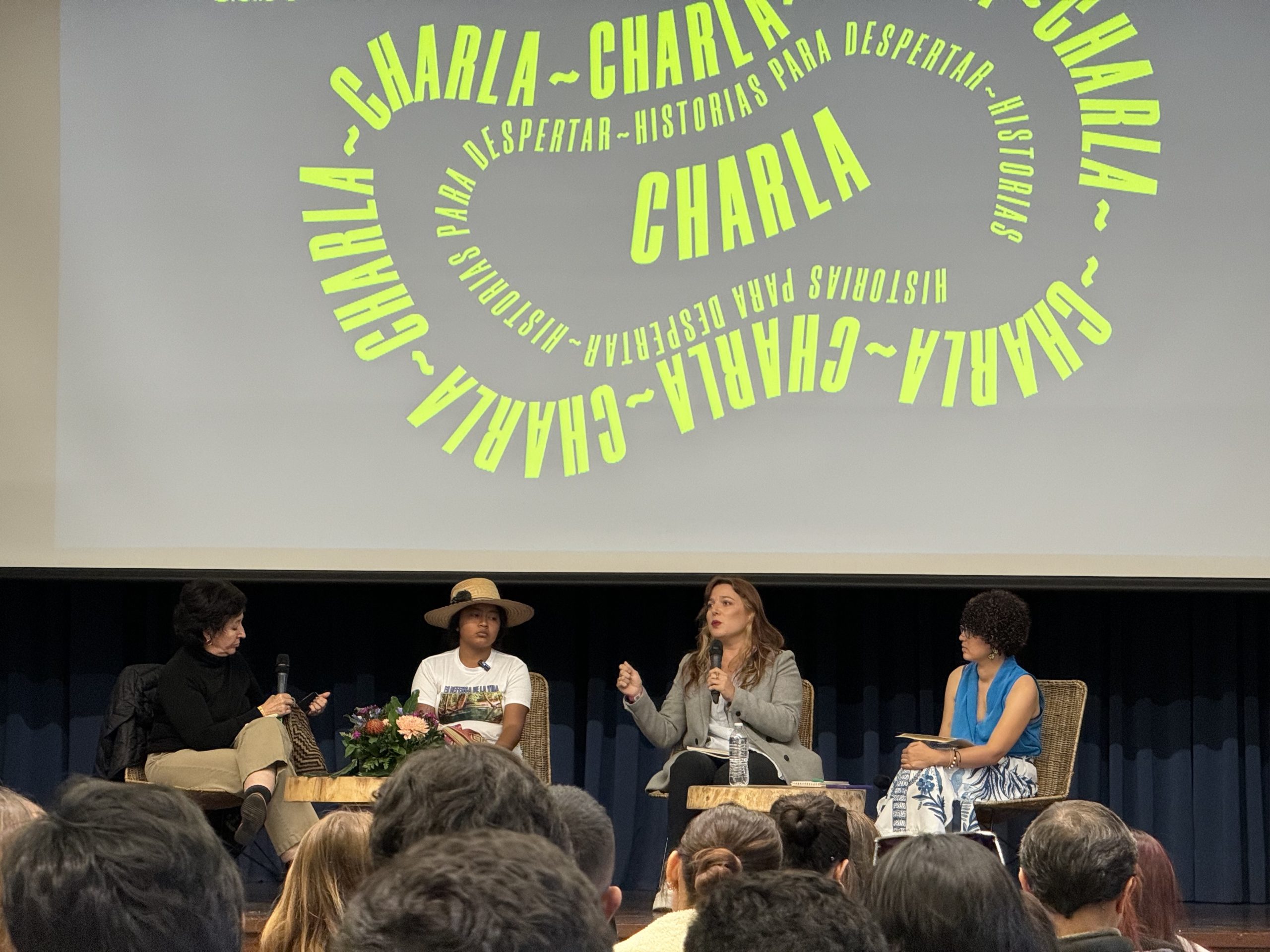“The collective is worth more than the individual, because what matters is quality,” said one of the four presenters at one of the dozens of talks at Festival Gabo 2024. I found this quote just now while flipping through my many scribbles in a notebook filled with learning. At the time these words clicked in my brain, leading me to write it down in huge letters. Now, in retrospect, it makes even more sense.
I represented El Colectivo 506 at this year’s festival—one of the most important events in Ibero-American journalism—full of curiosity and eager to connect with my Latin American colleagues. After five days in Bogotá, Colombia, I’m more convinced than every of the quality of journalism that our region produces day after day, and the importance of that work not only for our region, but also for the world.
The talk where I heard the phrase was “Look inside: local stories to awaken and diversify agendas.” María Teresa Ronderos, the director and co-founder of CLIP, was moderating a conversation between three Colombian media leaders who are working with community communicators. María Teresa herself represents the quality of our regional journalism, but as she said, it was the collective power of the four women before me that kept me tied to my notebook, writing and writing.
We spent days hearing about quality and dedication to journalism, talking about the challenges and needs of our community, and celebrating what we do. Below are the most essential lessons I took away.
Artificial intelligence (AI) makes journalists more important, not less
El Colectivo 506 has not yet explored artificial intelligence in depth. Apart from taking advantage of tools such as audio transcription, we have not yet delved into what it is and what it does.
That’s why one of my biggest motivations to attend the Festival was my selection for the workshop “Demystifying AI and investigating its impact,” with Karen Hao and Tatiana Dias, coordinated with the Pulitzer Center. I also attended Carolina Potocar’s talk, “Verify and investigate with artificial intelligence: tools to streamline your coverage,” coordinated by Google News Initiative (BNI). The activities had very different focuses.
With Carolina, I rediscovered GNI’s useful PinPoint tool and learned about Fact Check Explorer. Both tools use AI to support investigative work of journalists who must review a large amount of data and documentation, always under the tutelage of the journalist and with strict direction. At El Colectivo 506, we have not yet carried out this type of investigation—but as solutions journalists, we know that AI is a way to find positive variants of a negative trend, showing us possible answers to big problems. We hope to take that path soon.
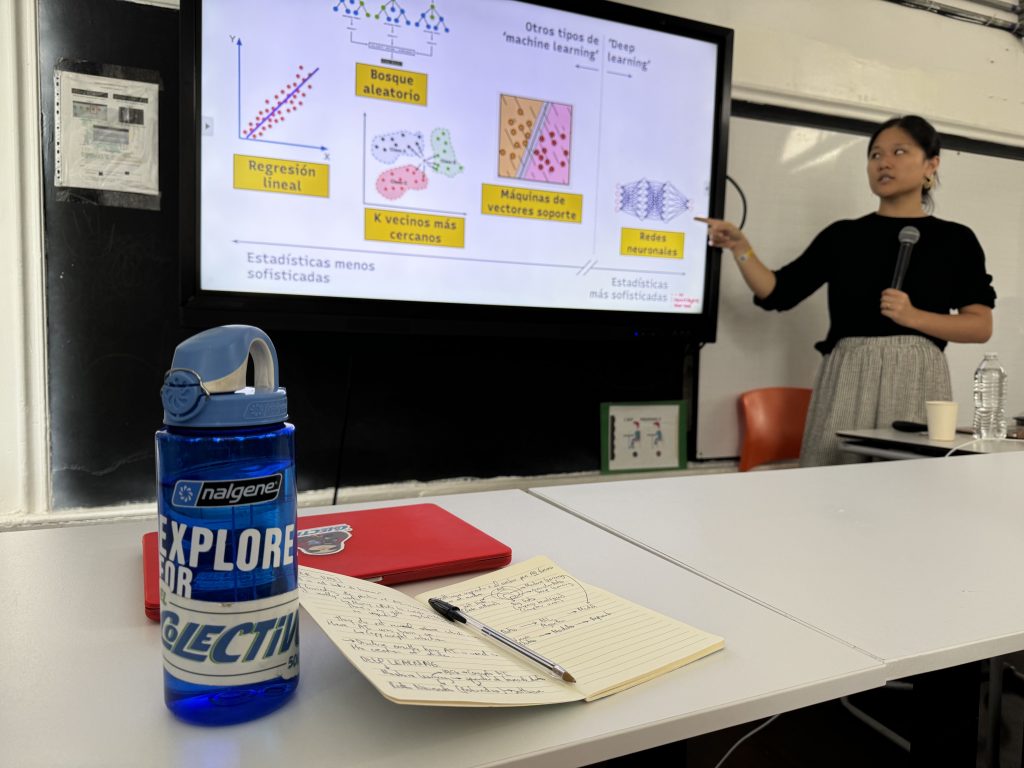
- Karen Hao presents the workshop “Demystifying AI and investigating its impacts” during the Festival Gabo 2024. Mónica Quesada Cordero / El Colectivo 506
I was so grateful to hear from Carolina after participating in the workshop with Karen Hao and Tatiana Dias.
Karen started with something basic, something for which I am grateful, and emphasized something very important: “AI is not better than humans,” she said emphatically.
The workshop lasted four hours, full of information. Here are a few surprises that stood out.
Of course, AI needs data in order to function—novels, images, our social media posts—and that data comes from people. That’s creating new forms of labor exploitation and colonization, as explained this series of articles from MIT. And this is why it’s important that everyone, but especially journalists who publish information about AI, begin to question where the data feeding that AI comes from, and how it’s being received. It’s very likely that none of these large companies want to give up this information easily, which should sound an alarm.
It’s common for AI to feed on data that, like anything humans generate, can be biased. As a result, this can perpetuate actions of discrimination and even violence.
I also learned that generative AI not only reviews existing data, but creates new data from it. What processes do these giant computers use to prioritize, differentiate, and even order the way they present new data? No one really understands. There are even cases where AI is being “audited” by another AI, further obscuring our understanding of how it works.
Once all this happens, there is no going back. That is, we do not know how to make AI “forget” what it was taught. If AI “learned” that people with certain physical traits are “more likely to commit crimes” (I invite you to read this report about it in ProPublica), because it was fed incorrect data, AI cannot make a moral assessment of what happened and change the way it works.
If we begin to depend more and more on these tools without the supervision and control of people, we begin to create very dangerous spaces. That’s why the role of journalists is increasingly important. We must apply our inquisitive and doubtful nature. We must also make sure no one forgets that in the end, AI is not better than people. AI depends on them.
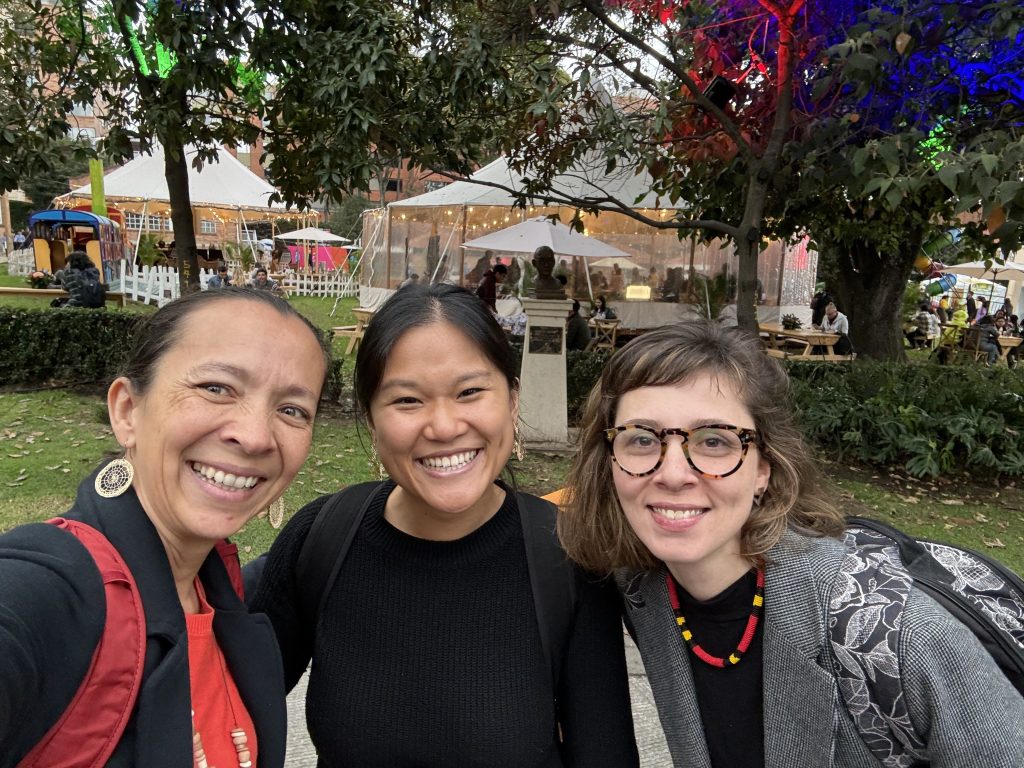
- Mónica takes a selfie with Karen Hao and Tatiana Dias after the workshop “Demystifying AI and investigating its impacts” during the Gabo 2024 Festival. Mónica Quesada Cordero / El Colectivo 506
We need journalism about AI—to denounce, but also to share solutions
When the workshop ended, I couldn’t help but ask Karen and Tatiana what role solutions journalists can play in all of this: as you can guess, I have trouble accepting that everything is negative. I mentioned Karen’s article on a community in New Zealand that is empowered by technology to conserve its language. The presenters pointed out the importance of transparency with all the communities involved about the processes that are used—from the type of data they were going to collect, to the way they will do it and how it will be used.
“This completely changes every step of the middle development process that large companies try to do, which is: not having any consent, entering these communities and simply taking the data without telling them what it is for, and continuing to use the data in perpetuity for all kinds of purposes and applications without any permission or consent,” Karen said.
She added that people who believe in the answers to problems must also work to showcase the movements that shine a light on the impact of AI on people. Such movements are already happening in countries such as Kenya and Chile.
If you want to hear more from Karen and Tatiana, you can watch their keynote talk (in English, with Spanish subtitles) on the Festival Gabo YouTube channel.
Measuring the impact of journalism? It’s a challenge
I entered Karen and Tatiana’s workshop as a newcomer to the world of AI, but when I sat down to listen to Florencia Aza and Naimid Cirelli from SembraMedia—an organization where I serve as the ambassador for Costa Rica—I thought I had a better handle on things. After all, they were there to talk about how to measure the impact of a media outlet, and after four years of co-leading El Colectivo 506, I figured I knew a lot about it. However, just like a self-assured teenager who suddenly realizes that she still has a way to go, it dawned on me over the course of the two-hour workshop that I still have a lot to learn.
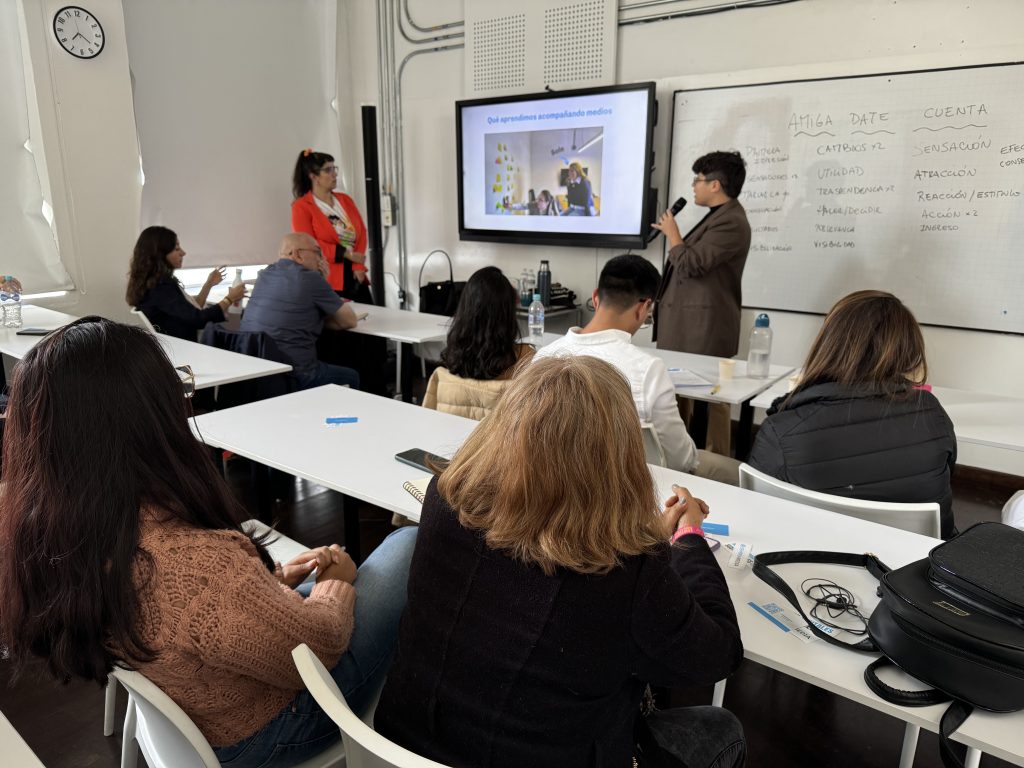
- Florencia Aza (left) and Naimid Cirelli from SembraMedia teach the workshop “Journalism and impacts: how to show the value of our work” during Festival Gabo 2024. Mónica Quesada Cordero / El Colectivo 506
Perhaps the most important lesson I learned from this workshop is that we cannot measure the impact of our environment if we do not have a clearly defined mission. That mission helps us define what is an impact for us. Of course, even with a clear mission, measuring impact often involves very complex processes.
Whether we lead a media organization or some other institution, family, or community, we need to define the objective that unites us, and then establish what success will mean for us. We can’t leave those decisions to people outside of the organization.
People are increasingly avoiding the news—and quality journalism seeks to change that
Although the Festival offered dozens of talks and workshops in venues all over Bogotá, I could only participate in a few more.
In his talk “Digital News Report 2024: how audiences are informed,” Eduardo Suárez, from Oxford University’s Reuters Institute, shared nine key points from the latest Digital News Report 2024. Point eight turned out to be the most worrying: the percentage of people actively avoiding the news increased by 3% between 2023 and 2024, reaching a global average of 39%. Eduardo pointed out that this number has increased each year since it began to be measured seven years ago. Back then, the percentage was 29%.
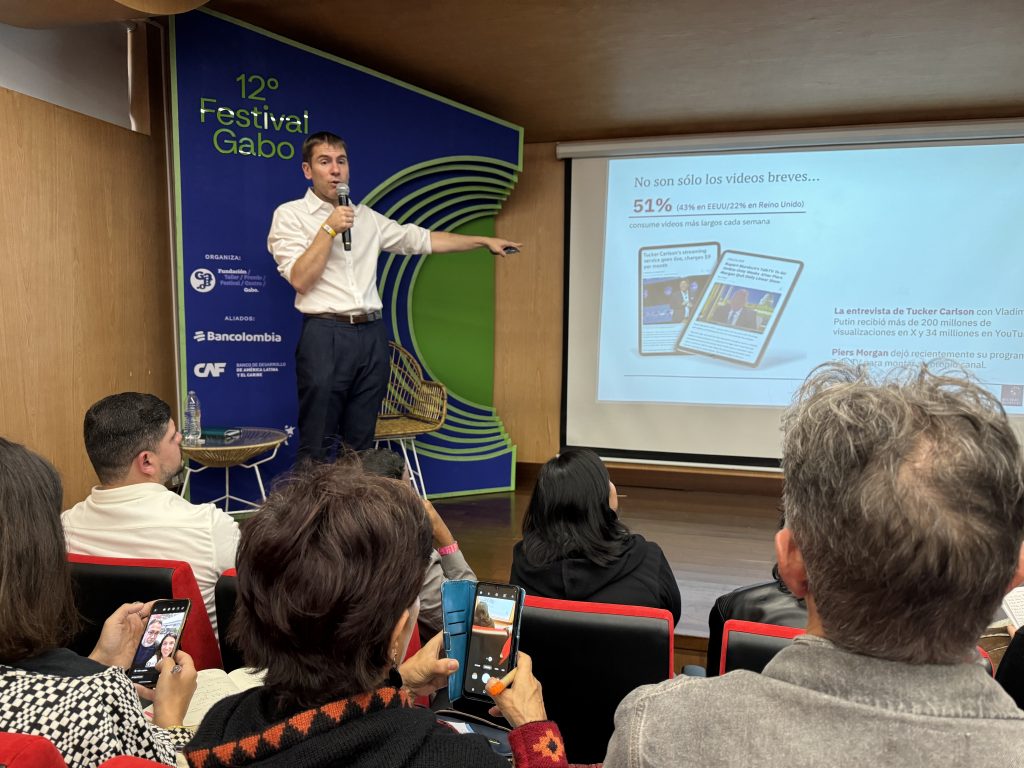
- Eduardo Suárez during his talk “Digital News Report 2024: how audiences are informed” at Festival Gabo 2024. Mónica Quesada Cordero / El Colectivo 506
“Look inside: local stories to awaken and diversify agendas,” which I mentioned at the beginning of the article, was deeply inspiring: three Colombian projects showed the impact of local news. I invite you to check out the Chagra Alliance of Visual Storytellers, from Baudo Public Agency, where storytellers from different communities in Colombia create audiovisual and physical experiences to tell the stories of their communities. Another is Agenda Propia (Our Own Agenda), which focuses on co-creation and the empowerment of local voices, especially indigenous peoples.
This is part of the essence of El Colectivo 506. While, for economic reasons, we have not always been able to hire as many local journalists as we would like, hearing the impact of these projects convinced me that it is the right path. It also confirmed for me that journalism lives not only in large newsrooms and with university degrees under its arm, but also in the basic need for everyone to share their reality.
All of this journalism deserves our support, and is just as important as investigative journalism. Of course, investigative journalism also shone at Gabo. I saw this when I listened to Michelle Carrere, editor at Mongabay Latamy, and Daniela Castro, editor for South America at OCCRP, in their talk “How to investigate the oceans without drowning in the attempt?”
While the talk itself failed to answer this metaphorical question, it never ceased to surprise me. Michelle and Daniela presented their investigations on illegal fishing and species trafficking, magnificent works of investigative journalism that showed me two important things. First, investigative journalism can be done on topics as complex and as invisible as what happens in our oceans. And second, to be able to do this, journalists need time and resources so they can learn and go deeper.
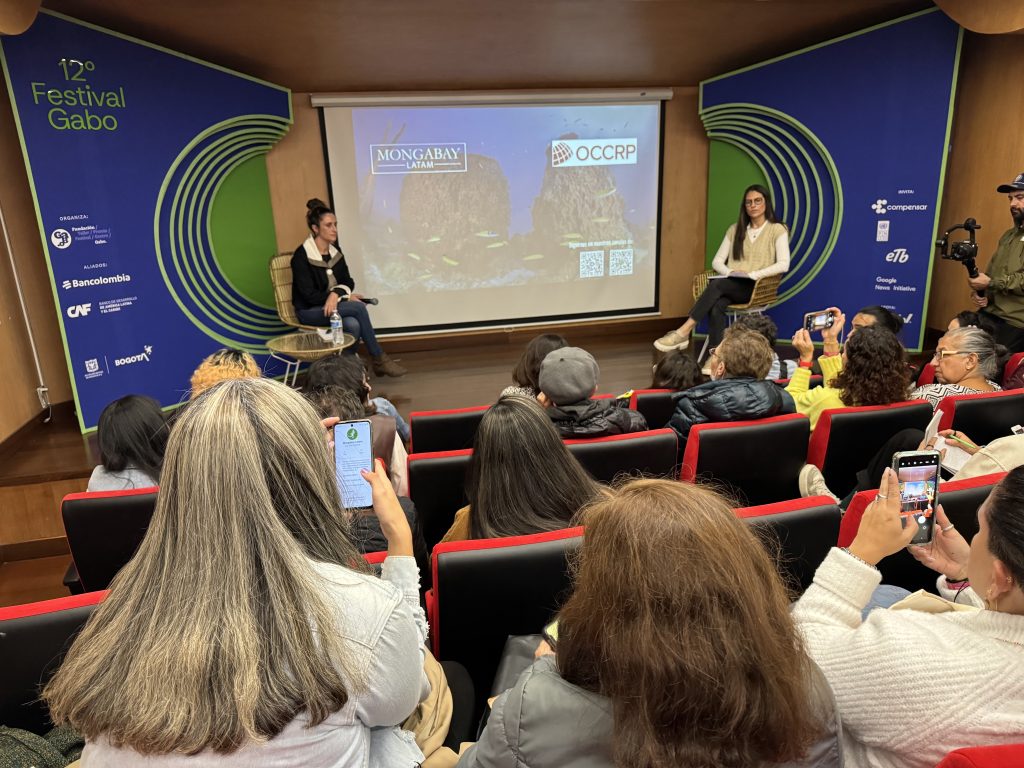
- Michelle Carrere (left) and Daniela Castro give the talk “How to investigate the oceans without drowning in the attempt?” during Festival Gabo 2024. Mónica Quesada Cordero / El Colectivo 506


